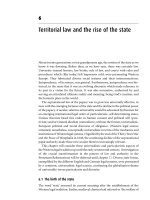- Trang chủ >>
- Khoa Học Tự Nhiên >>
- Vật lý
great god amighty the dixie hummingbirds celebrating the rise of soul gospel music feb 2003
Bạn đang xem bản rút gọn của tài liệu. Xem và tải ngay bản đầy đủ của tài liệu tại đây (4.04 MB, 385 trang )
Great God A’mighty!
The Dixie Hummingbirds:
Celebrating the Rise of
Soul Gospel Music
JERRY ZOLTEN
OXFORD UNIVERSITY PRESS
Great God A’mighty!
The Dixie Hummingbirds
This page intentionally left blank
Great God A’mighty!
The Dixie Hummingbirds
Celebrating the Rise of Soul Gospel Music
Jerry Zolten
3
2003
1
Oxford New York
Auckland Bangkok Buenos Aires Cape Town Chennai
Dar es Salaam Delhi Hong Kong Istanbul Karachi Kolkata
Kuala Lumpur Madrid Melbourne Mexico City Mumbai Nairobi
São Paulo Shanghai Taipei Tokyo Toronto
Copyright © 2003 by Oxford University Press, Inc.
Published by Oxford University Press, Inc.
198 Madison Avenue, New York, New York 10016
www.oup.com
Oxford is a registered trademark of Oxford University Press
All rights reserved. No part of this publication may be reproduced,
stored in a retrieval system, or transmitted, in any form or by any means,
electronic, mechanical, photocopying, recording, or otherwise,
without the prior permission of Oxford University Press.
Library of Congress Cataloging-in-Publication Data
Zolten, Jerry.
Great god a’mighty! the Dixie Hummingbirds:
celebrating the rise of soul gospel music
/ Jerry Zolten.
p. cm.
Includes bibliographical references and index.
ISBN 0–19–515272-7
1. Dixie Hummingbirds.
2. Gospel musicians—United States—Biography.
I. Title.
ML394 .Z65 2003
782.25'4'0922—dc21 2002005453
1 3 5 7 9 8 6 4 2
Printed in the United States of America
on acid-free paper
To my mother, Betty, my wife, Joyce, and my son, Zach
In memory of my father, Bam
In memory of my mentors, Gerald M. Phillips, James S. Hill,
Willie “Preacher” Richardson, and Walter Settles
This page intentionally left blank
Preface ix
1 “A Wheel in a Wheel, ’Way Up in the Middle of the Air” 1
(1916–1928)
2 “I Just Got On My Travelin’ Shoes” (1929–1938) 17
3 “Ain’t Gonna Study War No More”
(1939–1942) 49
4 “Twelve Gates to the City”
(1943–1944) 79
5 “Move On Up a Little Higher”
(1945–1949) 117
6 “My Record Will Be There”
(1950–1951) 155
7 “Let’s Go Out to the Programs”
(1952–1959) 203
8 “Loves Me Like a Rock”
(1960–1976) 261
9 “Who Are We?”
(1977 and Beyond) 301
Notes 322
Bibliography 338
The Dixie Hummingbirds on Record 347
Credits 357
General Index 359
Index of Groups 366
Gospel Song Titles 368
Contents
This page intentionally left blank
I was one of thousands of white kids who, in my case growing up
outside of Pittsburgh in the late 1950s and early 1960s, discovered the
exciting and—at the time—exotic world of black music hidden away at
the lower end of the radio dial. The station was WAMO out of Home-
stead, and the music—primarily jazz, rhythm and blues, and
doo-wop—was impossible to ignore. In my town, McKeesport, the
station and the music came to signify teen rebellion, an intelligent
underground alternative to the bland pop that then dominated main-
stream airwaves. By the time I graduated from high school, I had
amassed thousands of choice 45-rpm records by African American
performers the more obscure the better.
It was around then that I chanced on a segment of the WAMO broad-
cast day that I had never before heard. Sunday mornings, after all, were
not prime time teen listening hours. In fact, had I not been out Saturday
night from dusk till dawn, I would have missed the Sunday morning
broadcast altogether. I no longer remember who hosted the program,
but the music was inescapably captivating, emotive beyond anything I
had ever heard during regular weekday broadcasts—rocking choirs,
screaming preachers, sanctified divas, and sublime vocal groups with a
soul feel that at the time was simply not present on the secular side. It
was a revelation that fueled my desire to discover the world of black
gospel music.
Over the years, I sought out records that pulled me deeper and
deeper into the history of the genre. The 12-inch 33–1/3s in the card-
board sleeves and the 45-rpms took me back only so far, but the 78-rpms
opened a window on the rich landscape of black religious music
stretching back across decades.
In time, I sought out live performances of the music, sometimes at
local churches, other times at festivals and concerts where famous acts
were scheduled to appear. It was in that context that I first met some of
Preface
the gospel artists I so admired. My closest association early on was with
the Fairfield Four of Nashville, Tennessee, one of the great touring,
broadcasting, and recording groups of the prewar era. Starting in the
early 1980s, I toured with them, spent nights in their homes, talked for
hours, and eventually produced the CD that spearheaded their return to
commercial recording. It was on tour with the Fairfield Four in
Rochester, New York, that I at last met one of my favorite groups, the
Dixie Hummingbirds. We became fast friends, and over the years these
men—from the Fairfield Four, James Hill, Isaac Freeman, Willie
Richardson, Reverend Sam McCrary, Wilson Waters, Robert Hamlett,
and Walter Settles, and from the Dixie Hummingbirds, James Davis, Ira
Tucker, James Walker, Paul Owens, Howard Carroll, and Carl Davis—
became my teachers.
From them, I learned that black gospel was multifaceted—witnessing
to faith, spiritual epiphany, deeply rooted tradition, inspirational enter-
tainment, sophisticated rhetoric, and much more. I saw that the music
was culturally bound, its greatest stars barely known outside the African
American community, the full measure of its influence on blues, jazz,
R&B, doo-wop, and soul appreciated mostly by cultural insiders or
those who studied the music.
There was also paradox. This was a realm of music whose players
because of religious connotation and spiritual power were perceived as
holier-than-thou by the public. As several performers put it to me,
“They expected us to be wearing wings.” And it was an image that
many performers admittedly and necessarily projected—living the life
they sang about.
The reality was that gospel, like any other human endeavor, was
populated by people of every type and temperament. There was rivalry,
jealousy, womanizing, substance abuse, and even violence. But there
was also generosity, devotion to family, loyalty, perseverance, sacrifice,
mentoring, and a wealth of immeasurable talent. Of all the groups that
traveled the gospel highway, none succeeded better than the Dixie
Hummingbirds at living up to these latter qualities. It would become
the backbone of their reputation and subsequent success.
There was also the Dixie Hummingbirds’ unparalleled ability
through performance to unite people into a “oneness” that transcended
religious belief and even no belief at all. Ultimately, that was the special
magic that inspired me to write this book and, in the process, come
together with the many people who, by telling their stories, helped me
tell the story of the “Gentlemen of Song,” the Dixie Hummingbirds.
x
Preface
First and foremost, I want to thank James Davis, founder and patri-
arch of the Dixie Hummingbirds, for sharing so much about his
personal life and the early history of the Birds, and, along with him,
legendary Birds’ lead singer Ira Tucker, Sr., who guided me through his
early years and key moments in the group’s golden years. His wife,
Louise Tucker, provided invaluable help, as did his son Ira Tucker, Jr.
(vital!), and daughters Sundray Tucker and Linda Lawrence.
Thanks to the many singers and instrumentalists who offered their
perspective on the Dixie Hummingbirds. From the Birds, cofounding
member Barney Parks, the late James Walker, the late Beachey Thompson,
Howard Carroll, Paul Owens, Carl Davis, William Bright, and Joe
Williams. Thanks to Minnie Lee Baker and Carrie Thompson, widows
respectively of Wilson “High Pockets” Baker and Beachey Thompson.
Thanks to Claude Jeter of the Swan Silvertones, Morgan Babb of the
Radio Four, Thermon Ruth of the Selahs, Carey “Squeaky” Bradley of
the Kings of Harmony, Isaac “Dickie” Freeman and the late James Hill of
the Fairfield Four/Skylarks, Ed Sprouse of the Blue Ridge Quartet, Willa
Ward-Royster of the Famous Ward Singers, Margaret Allison of the
Angelic Gospel Singers, Horace Clarence Boyer of the Boyer Brothers,
Arthur and LeRoy Crume of the Soul Stirrers, Joe Ligon of the Mighty
Clouds of Joy, and Marie Knight.
Thanks to Paul Simon, Stevie Wonder, Solomon Burke, Sam Moore,
Isaac Hayes, Tommy Hunt of the Flamingos, Otis Williams of the Temp-
tations, Prentiss Barnes of the Moonglows, Hank Ballard of the
Midnighters, Jerry Butler of the Impressions, “Little” Anthony Gour-
dine of the Imperials, and Jimmy Merchant of the Teenagers.
Thanks to Roxie Moore, who wrote great songs for the Humming-
birds, and to Evelyn Johnson, who ran the day-to-day business of
Peacock Records and the Buffalo Booking Agency. Also to Morris Ballen
and Paul Fine of Ballen Records; the late Fred Mendelsohn, producer at
Savoy Records; Bruce Bastin, who made available material from Gotham
Records, and Andy McKaie, who made available session notes from the
Peacock archives.
For background and personal memories of the Hummingbirds,
thanks to Dr. Maya Angelou; Reverend Dr. Gadson L. Graham; pro-
moter Willie Leiser; Greenville, South Carolina, residents Patria Ross,
Mamie Norris, and Blanche McIver; Aurelia and Kazava Smith, widow
and son of the late Holden Smith; Curtis Rudolph, lifelong friend to Ira
Tucker, Sr.; Darryl Williams, son of Philadelphia disk jockey Kae
Williams; and Lula Mae Watts, cousin to Birds bass singer William Bobo.
Preface xi
I am indebted to fellow researchers Doug Seroff and Ray Funk for
sharing advice and materials and especially for providing interview
transcripts with Beachey Thompson and Robert Hardy. I would also like
to thank David Evans, Ray Allen, Alan Balfour, Chris Smith, Howard
Kramer, Alan Govenar, Eric LaBlanc, Opal Nations, Anthony Heilbut,
David Ritz, Roger Wood, and Alan Young. Special thanks to Phil Klass,
aka William Tenn, for inspiring me to write, and Herman Cohen, pro-
fessor emeritus and valued mentor, for talking out so many of the
details with me. Thanks also to Craig and Donna Rothman for the loan
of a dock, to Chris Rosenblum for helping me get the balloon aloft, and
to old friend Van Dyke Parks for “rah rah-ing” me on. And to my brother
Sam for encouragement, hospitality, taking all those pictures for free,
and explaining how to get through one end of Philadelphia to the other.
Thanks to Bill Barke who made vital connections; to Barbara Brun-
huber and Cindy Mighells, who transcribed many an interview; to Josh
Ferko and Kris Kehr, who made rare records available and burned them
onto CD; and to my colleagues at Penn State Altoona, especially Dinty
Moore, Michael Wolf, Kjell Meling, and Ken Womack.
Special thanks to the Penn State Altoona Dean’s Development Fund,
the Pennsylvania Humanities Council, the Greenville African American
Museum, and, on the home front, to my wife, Joyce, and son, Zach, who
spent many an evening wondering when Dad was finally going to
emerge from his writing room.
xii
Preface
Great God A’mighty!
The Dixie Hummingbirds
In the beginning, after the word, before rock ’n’ roll, and before there
was rap, hip-hop, disco, punk, funk, metal, soul, Motown, rock-a-billy,
before bebop, doo-wop, and the big band swing, there was the Dixie
Hummingbirds. The mighty Dixie Hummingbirds.
They sang through the Great Depression, the terms of thirteen presi-
dents, four major wars, five generations of Americans, and seven
decades of the twentieth century.
The Dixie Hummingbirds. They personify perseverance, talent, and
dedication. Now, the iron men of gospel are celebrating their seventy-
fifth anniversary. The Dixie Hummingbirds are indeed an American
institution. Ladies and gentlemen, I give you the gentlemen of song—
the legendary Dixie Hummingbirds.
—Isaac Hayes
Ezek’el saw the wheel, ’way up in the middle of the air,
Ezek’el saw the wheel, ’way up in the middle of the air,
The big wheel moved by faith,
The little wheel moved by the grace of God,
A wheel in a wheel, ’way up in the middle of the air.
–Traditional African American Spiritual
“A wheel in a wheel.” So go the words of the old African American spir-
itual. No one knows exactly what the ancient biblical images meant, but
they do coincidentally resonate with the life of James B. Davis, founder
of the trailblazing Dixie Hummingbirds. His entire existence, so it
seems, has been caught up in wheels within wheels.
The first was the circle of racial apartheid. He grew up in a small
southern town, part of an African American community forced by the
white majority to exist within the confines of institutionalized segrega-
tion. The second was gospel music. Though at the center of all African
American music, it was always a sphere of entertainment unto itself.
Davis and the Hummingbirds would be giants within the genre, but not
nearly as well known or as rewarded as they would have been had they
opted for the entertainment mainstream. The third and last circle was
his life in retirement. No longer active as a performer, he was living once
again in a community within a community, the inner city of Philadel-
phia surrounded by relatively affluent suburbia all around.
The story of the Dixie Hummingbirds rightly begins with the coming
of age of James Davis. He is prototypical of the founding fathers of
modern black gospel music. His experiences growing up in the 1920s
1
“A Wheel in a Wheel,
’Way Up in the Middle of the Air”
(1916–1928)
in a black community in the segregated South had everything to do with
the Dixie Hummingbirds—the direction they took, the music they
performed, and the impact they ultimately had on gospel music as a
genre.
As for the music, black gospel is nothing less than communication
about culture, far more profound than a mere litany of names, dates,
and places. The music is intrinsically linked to life experience and the
struggle of African Americans to persevere in a society that, as Bernice
Johnson Reagon put it, “debated our worth as human beings.”
1
Without a doubt, seedtime for the Dixie Hummingbirds begins with
young James Davis. Looking toward a lifetime of drudge work in his
hometown, Greenville, South Carolina, he chose to make music his
saving grace. He brought the dignity he found in performance to a
personal vision that would ultimately shape the Dixie Hummingbirds.
It was a bitter cold February day in Philadelphia, 1995. Guided by
Ira Tucker, Jr., son of the Dixie Hummingbirds’ famed lead singer, Ira
Tucker, Sr., we were on our way to meet James B. Davis, the group’s
retired patriarch. Hunkered down in our coats, we walked briskly,
trying to minimize the bite of icy cold winds that barreled down the
corridors of the inner city streets. Davis had not sung or traveled with
the group for years. Nonetheless, he was still—as far as the group was
concerned—their guiding light, a man to be treated with deference and
respect. In my eyes, he loomed larger than life, a cultural hero of sorts,
the rare person whose artistic endeavors had actually become part of
the American folk tradition. Quite honestly, I was in awe and nervous
about meeting him.
James Davis was a founding member of the Dixie Hummingbirds,
and, over the group’s seventy plus years as a performing entity, the
cohesive force that held them together. As a group, they had come to
be so revered within the African American community that calling them
“legendary” would not be the least bit gratuitous. Davis was with them
in 1928 at the start. He saw them through the Great Depression when
they were barely known outside of Greenville County, South Carolina.
He stood at the helm through their best years when the Dixie
Hummingbirds helped shape the sound of soul gospel music. But the
glory days were past and gone, and Davis, now in his 80s, long retired,
a bit reclusive, was living in the inner city Philadelphia brownstone he
had purchased back when the building and the neighborhood had been
top of the line.
2
Great God A’mighty! The Dixie Hummingbirds
When the idea to chronicle the story of the Dixie Hummingbirds orig-
inally came up, Ira Tucker, Sr., now the keeper of the flame, was quite
clear that James Davis had to be the first person interviewed. As we got
closer to the Davis home, Ira, Jr.—“Gramp,” as his closest friends called
him—continued prepping to make sure everything started off smoothly.
“Mr. Davis is eccentric,” he said. “Odd. He has strong ideas.” Davis had
always been remarkably, sometimes mystifyingly, firm in his beliefs,
stubbornly insistent about the “right” way to do things. For the
moment, that meant no four-letter words of even the mildest kind or
anything that might upset his sensibilities.
Even though he was not a member of the Hummingbirds, Ira
Tucker, Jr., was also raised within the orbit of James Davis’s influence.
He was the kid who stood in the wings at Harlem’s Apollo Theater
back in the 1950s, watching and absorbing as his father, Davis, and the
others worked their soul-wrenching magic on the crowd, people
screaming and shouting, some doing holy dances right there in the
theater aisles. The Hummingbirds were at the top of their game and
James Davis was calling the shots. Even then, Ira, Jr., knew that James
Davis was a force to reckon with. Now, back on the cold streets of
Philadelphia, as we at last approached the house, Gramp’s respect was
evident in how, even outside the man’s presence, he still talked about
him as Mister Davis.
“There seemed nothing ‘odd’ about the man who greeted us.”
The house stood in a block-long row of connected narrow brownstones
in a neighborhood that had been upscale when Davis had originally
bought there but was now rundown and shabby. The Davis house,
though, was an exception, well maintained in the midst of abandoned
boarded-up buildings, the gang-turf graffiti spray-painted on every
available surface.
Davis was a man who had never permitted racism to block his
progress, so it seemed fitting that he lived in the shadow of a 100-year
old stone wall that had come to represent a victory over racism in the
City of Brotherly Love. The wall surrounded the Girard School,
isolating the institution, hiding its grounds from public view. Philadel-
phia financier Steven Girard founded the school in the 1830s and
stipulated in its charter that room, board, and a free education be
provided to orphan boys—white only. African Americans were to be
excluded. The policy remained intact for decades and, for the African
“A Wheel in a Wheel, ’Way Up in the Middle of the Air” 3
American citizens of Philadelphia, came to symbolize institutionalized
segregation. By the 1960s, with the neighborhood around Girard School
almost entirely black, the stone wall stood as a constant and bitter
reminder of those prejudices.
2
But through the efforts of an African
American attorney, Cecil B. Moore, the Girard School policies, like the
walls of Jericho, came tumbling down. Today, Cecil B. Moore Boulevard
runs through the neighborhood, and the wall, no longer symbolic of a
barrier to overcome, now signifies a battle fought and won. An apt
setting for the residence of Mr. James B. Davis. We at last arrived at his
door and knocked.
There seemed nothing “odd” about the man who greeted us. James
Davis was tall, handsome, elegant, and most gracious. He was soft-
spoken, a bit raspy as if all those years of singing had taken a toll on his
voice. His clothes were heavy against the chill he evidently felt even
inside the house. He invited us into a long dimly lit narrow living
room. A lifetime of career mementos stood on shelves and hung on
walls all around the room—fading sepia-toned photographs, trophies,
gold records, and the Grammy award won in 1973 for the Humming-
birds’ version of Paul Simon’s pop hit, “Loves Me like a Rock.” We sat
back, Davis across from us on the sofa as he began reflecting on the
beginnings of the Dixie Hummingbirds and the days of his youth in
Greenville, South Carolina, in the 1920s.
“No connection with the whites at all!”
Greenville is a city on the Piedmont plateau near the foothills of the Blue
Ridge Mountains. In the 1920s, when James Davis was growing up there,
almost 29,000 people lived in Greenville, more than a third African
American.
3
Mamie Norris, born there in 1906, knew James Davis by
reputation and has vivid memories of Greenville from their childhood
days. Her family had a house near the train station. “Right at the
Southern depot,” she says. “We had a lot of trains then. The Southern
Railway—that was the biggest mode of transportation at the time. From
New York to New Orleans, right through Atlanta, Birmingham. It was
called the main line. Greenville also had 18 cotton mills, one of the
largest cotton mills in the world under one roof.”
4
But while the jobs were plentiful for African Americans in Greenville,
as in every other southern city, segregation was the law of the land
there, and civil rights were routinely denied to African Americans.
4
Great God A’mighty! The Dixie Hummingbirds
James Davis, founder of the Dixie Hummingbirds, 2000. Photo by
Sam Zolten.
A story in the Greenville News circa 1928 exemplified the circumstances.
One Bishop Hall, “a Negro,” had been caught “making whiskey.” The
judge ordered Hall to sign “an agreement to permit police officers to
search his home at any time day or night, with or without a warrant
and search for whiskey.”
5
This was the Greenville that James Davis
knew. The city’s African American community lived as well as they
could within those parameters, closing ranks against the outside
hostility. People worked around it, rose above it, and pressed on at their
own pace and terms. “Wholly segregated,” said Mamie Norris, resigna-
tion in her voice. “No connection with the whites at all.”
Barney Parks has similar recollections. He and Davis teamed up as
singing partners when they were kids, forming the core of what would
become the Dixie Hummingbirds. Parks sang with the Birds until he
was drafted in World War II, but continued after the war to work with
them and other gospel artists as a booking agent. Nowadays, Parks was
long retired and grappling with serious illness. He talked matter-of-
factly about the past, laughing occasionally, but even after all these years
he was still bitter about his experiences as a person of color in segre-
gated Greenville. “Greenville was a prejudiced town, very much so.”
See, we didn’t have any problems because we knew the situation. We
knew how things were, and it didn’t bother us. We knew how to stay
in our place. When you know something and just go ahead, you’re
looking for trouble. But you can avoid that. We just didn’t have any
dealings with whites. [laughs] That was off limits! [laughs harder]
Yeah, I’m telling you! We knew how to act around people.
In the 1920s, Greenville’s African American community pulled
together, formed a circle unto itself as protection from the indignities
and pitfalls that existed on the outside. Blanche McIver, who grew up
with Parks and Davis, has never forgotten how the lines were drawn,
but she underscores that family and community helped everyone get
through.
They had black movie houses—I went to those. When they opened
up the theaters, the blacks sat in the balcony. I didn’t think nothing
about it. They had stores uptown on Main Street that wouldn’t let you
try on clothing. The hell with them, ‘cause when they put the money
in the drawer, it is all green, isn’t it? I didn’t know Greenville was
segregated. Didn’t make any difference to me. That’s the way it was.
6 Great God A’mighty! The Dixie Hummingbirds
We got everything we wanted within the black community. I give all
the credit to my mother. She used to say, “Be yourself and you don’t
have to bow down to anybody!”
6
This was the world in which James Davis and his family and friends
lived. The irony was that institutionalized segregation, at least in
Greenville, clearly had an unintended result. True, blacks may have
been deflected from the mainstream, but the result was the flowering
of a distinctly African American homegrown culture. The black people
of Greenville had their own social activities, entertainments, shops,
markets, businesses, schools, and churches. From all accounts, the
African American community of Greenville in the 1920s and early 1930s
functioned as an extended family, the “village” that raised the child. The
children of Greenville, as much as one can generalize, were taught a
healthy respect for their elders.
This certainly seems to hold true for James Davis. To this day, he
credits the teaching of his elders—parents, teachers, clergy, and
friends—with providing the foundation he brought in later years to the
Dixie Hummingbirds. Even with their faults, he speaks respectfully of
what he learned from his parents, John and Jannie Davis.
“My daddy was smart. My mother said he was a ‘pimp.’”
James Davis was born in Greenville on June 6, 1916. The Davis home
was on Meadow Street, a neighborhood of shotgun houses across the
Reedy River from downtown Greenville. Even though it was west of the
city, that part of town was called the Southern side because the Southern
Railway tracks ran close by. The neighborhood itself was called
“Meadow Bottoms” because it flooded every time the Reedy River over-
flowed. The houses were built up on high foundations so that
floodwaters could pass harmlessly underneath. “My mother, Jannie, was
a dark woman. John, my dad, was light-skinned, about my color. There
were three of us kids, but only my sister lived. My brother died.” John
Davis had a profound impact on young James. “My daddy caught
himself preparing me for everything. He sat me down and told me how
things were.”
John Davis offered lessons in both physical and spiritual survival.
Times were financially tight for African American people all across the
rural South. “Think about this time,” says James Davis. “It was very
poor. I think my mother made about seven dollars a week. She was a
“A Wheel in a Wheel, ’Way Up in the Middle of the Air” 7
cook.” But John Davis always seemed to have what he needed. “My
daddy was smart,” says James Davis. “My mother said he was a ‘pimp,
a good looking old pimp of a daddy.’”
Of course, Mrs. Davis meant what she said more figuratively than
literally. John Davis was in fact strictly honorable and religious. She
labeled him a “pimp” because he masterfully maintained the illusion
that he worked for a living. With no visible ties to any job, he always
seemed to have a dollar in his pocket. James Davis, like most members
of the community, had a great deal of respect for his father, recalling,
“Everyone thought he was a preacher. He was always glad, and I never
heard him use a bad word. He didn’t drink, didn’t smoke, didn’t curse,
but he liked to go when he wanted to, come back when he pleased,
work when he wanted. My mother, she just about had my daddy right
in some kinda way.”
Although he was not a preacher, John Davis was a spiritual man with
firm ideas about right and wrong rooted in the Bible. He and Jannie
were avid churchgoers. “My mother spent her whole life in church,”
says James Davis.
My mother believed in growing wings, so to speak. But my dad was
a guy that couldn’t be pinpointed too well. Most people thought he
was a preacher. But he wasn’t a preacher. He was a guy with his kind
of integrity. I’m a lot like him—a little odd. Most people think I’m
odd. Never been interested in blues and stuff like that. Never been to
a dance.
James Davis seemed to take a certain pride in being labeled “odd.”
For him, it meant he measured up to the ideals his father had planted
in him all those years ago. To James Davis, being “odd” was synony-
mous with having “integrity,” meaning he had a clear set of righteous
rules and the discipline to stay true to them. Determined to be a man of
unusual principle, James Davis would bring these values to his work
and his music. “I’ll tell you, my daddy made sure that I had my feet on
the ground solidly.”
The summers found James Davis away from home working on his
mother’s family farm in nearby Lawrence County. All he gained from
the experience was the certainty that physical labor was not for him.
They’d be working on the half, what they called “sharecropping,” one
of these set-ups where you work all year, and at the end of the year,
8 Great God A’mighty! The Dixie Hummingbirds
the men that owned the land would come in and say, “Well, we barely
broke even, but we’ll make it up to you next year.” In other words, we
barely got fed or paid off.
I don’t remember having received a quarter in three years, but I ate
better there than I did at home. One day the boss man said, “I wish I
had your appetite.” And I said, “You mean you want that, too!”
“If you don’t know where music came from . . . you don’t know anything about it.”
Music was an important part of community life in Greenville, and espe-
cially so within the Davis family. As far back as James Davis can
remember, his father was caught up in religious music and singing. “My
daddy was a master of music—period!”
He was one of those guys who would come up and say, “If you don’t
know where music came from, where it’s going, and how fast it’s trav-
eling, you don’t know anything about it!” Now that’s the kind of
fellow he was.
He liked church music. He was a singer. He would sit down, sing
the notes first and then the words of the song. And he loved to be able
to sing it four or five different ways. When he was finished with that
one, the next day, another song. I guess he knew so much about how
a song was made. He didn’t ever become attached to no song. But he
loved all of them. Maybe he’d get another book, wherever it opened,
that was his song.
Unlike his son, John Davis never thought to earn a living in music.
For him, the reward was in the sheer mastery and in the intensity of the
commitment. Although James was too young to understand his father’s
philosophy of music, he did learn some musical skills, such as the tech-
nique of “shape note” singing. “The reason it’s called ‘shape note’ is
because, like the words say, there are shapes for each note.”
Like “doh” was a triangle, go to “re,” a half moon, and what not. The
shapes were a standard thing from church to church. And that was a
short way to learn music. You associate the shape with the note.
He called me in the house one day, he says, “Bodee, [a nickname
his closest friends still call him today] this is a ‘doh.’” He was making
shape music. “This is the foundation of music, right here, this note.” It
was shaped like an Indian teepee. So, he said, “This is a ‘doh.’ It’s the
“A Wheel in a Wheel, ’Way Up in the Middle of the Air” 9
first letter in music. It’s the last one in music. This is the foundation.
You always come back to this.”
I wasn’t certain what he was talkin’ about. I had a pocket full of
marbles. I just looked at him and went back outside and began to
shoot my marbles. He called me back in about 15 minutes and asked
me what that was. And I said, “I don’t know.” He snatched me up
off the floor and looked at me. When he got angry his eyes danced,
you know. He’d say, “I’m your daddy. Hear me when I talk to you.”
“If you could sing, even though you might be black, people like you anyway.”
While James Davis may not have immediately picked up his father’s
passion for music, he was intrigued by the many styles he encountered
around town. First and foremost, there was church. He loved the
harmonies and the big sound of the choir, a group that, in a few years,
he would be old enough to join. He was also taken with the solo singers,
the unself-conscious souls who, without benefit of training, threw them-
selves totally into hymns they sang in church on Sunday, the entire
congregation rocking and swaying as they kept time with hands and
feet and the occasional tambourine.
Then, there were the needle-worn Victrola records his parents played
at home, a cappella quartets just beginning to explore the emotive possi-
bilities of the old spirituals. James Davis also remembers encounters on
the streets of Greenville with itinerant sanctified singers, some accom-
panying themselves with guitar, some starkly solo voice, but in either
case trying to entice any spare change they could from compassionate
passers-by. But the performance that he remembers really first caught
his attention was by a nameless preacher who had been invited to sing
at his school.
When I first fell in love with singing, a guy came to our grade
school—a preacher—and he was singing a cappella—by himself. He
had so much feeling that the people there went crazy over what he
was doing. Now, he wasn’t even singing in time. He sold his music
through expression and feeling. You talk about soul. Man, that old
man had some soul! I can almost hear him now.
James Davis was drawn to the idea that music could touch its
listeners’ emotions. Music was a way to connect to people and possibly
even earn a decent and respectable living. Davis was aware of a
10 Great God A’mighty! The Dixie Hummingbirds









